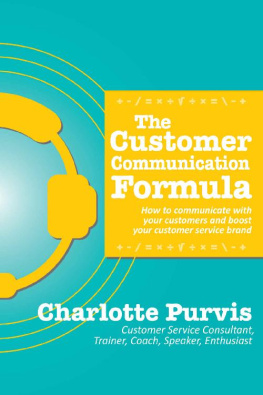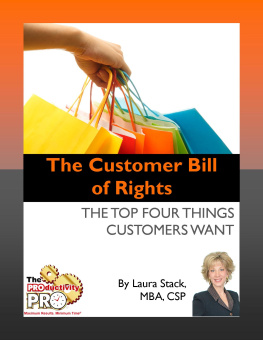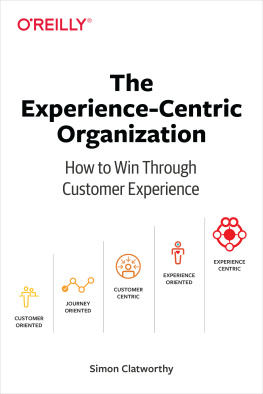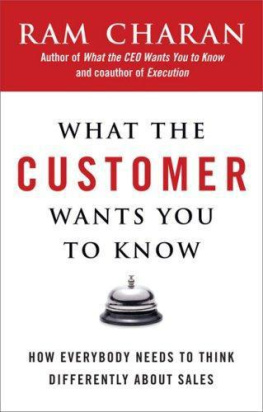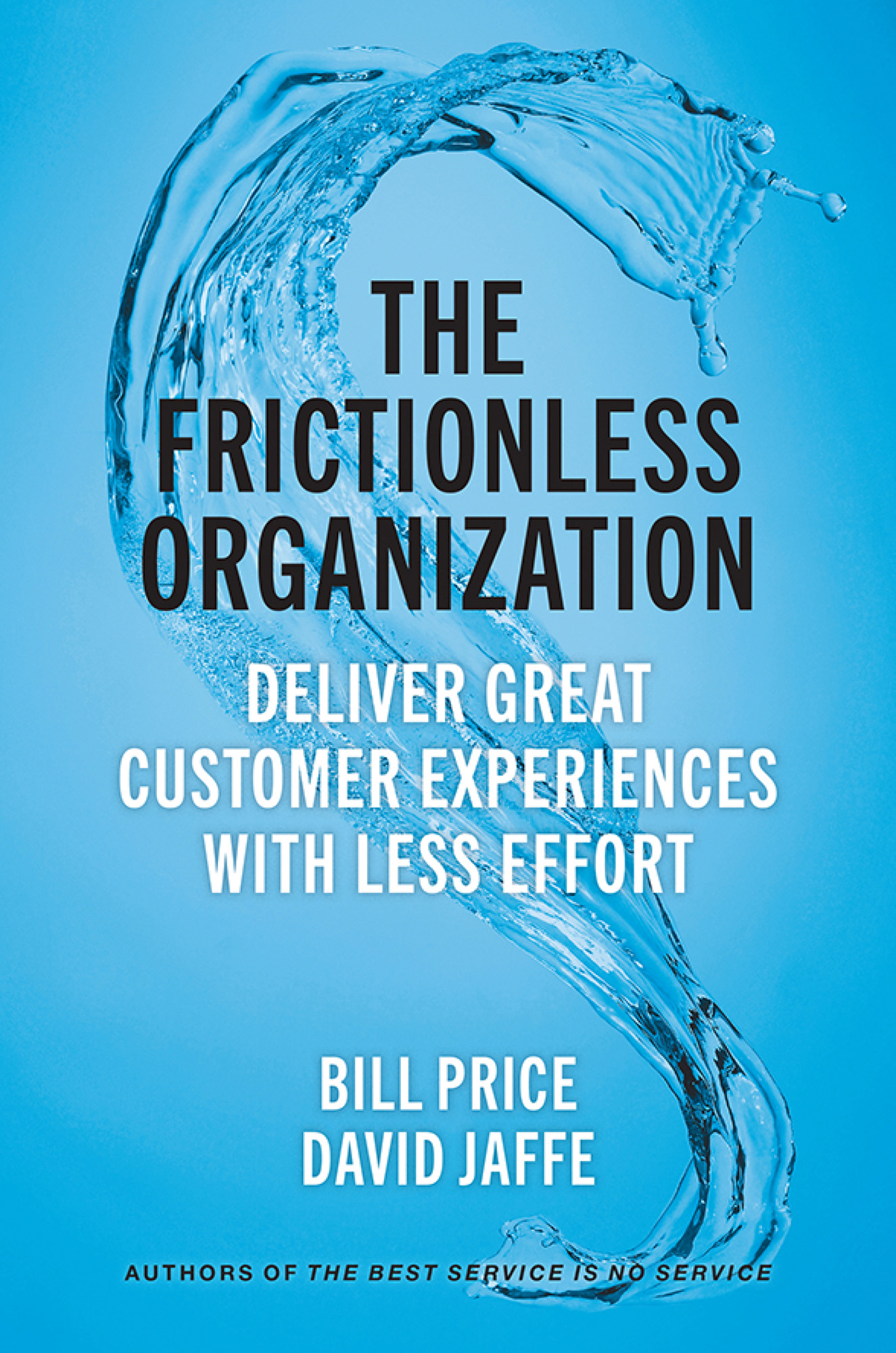Contents
Guide
Page List
THE FRICTIONLESS ORGANIZATION
THE
FRICTIONLESS
ORGANIZATION
DELIVER GREAT
CUSTOMER EXPERIENCES
WITH LESS EFFORT
BILL PRICE
DAVID JAFFE

The Frictionless Organization
Copyright 2022 by Bill Price and David Jaffe
All rights reserved. No part of this publication may be reproduced, distributed, or transmitted in any form or by any means, including photocopying, recording, or other electronic or mechanical methods, without the prior written permission of the publisher, except in the case of brief quotations embodied in critical reviews and certain other noncommercial uses permitted by copyright law. For permission requests, write to the publisher, addressed Attention: Permissions Coordinator, at the address below.

| Berrett-Koehler Publishers, Inc. 1333 Broadway, Suite 1000 Oakland, CA 94612-1921 Tel: (510) 817-2277, Fax: (510) 817-2278 www.bkconnection.com |
Ordering information for print editions
Quantity sales. Special discounts are available on quantity purchases by corporations, associations, and others. For details, contact the Special Sales Department at the Berrett-Koehler address above.
Individual sales. Berrett-Koehler publications are available through most bookstores. They can also be ordered directly from Berrett-Koehler: Tel: (800) 929-2929; Fax: (802) 864-7626; www.bkconnection.com
Orders for college textbook/course adoption use. Please contact Berrett-Koehler: Tel: (800) 929-2929; Fax: (802) 864-7626.
Distributed to the U.S. trade and internationally by Penguin Random House Publisher Services.
Berrett-Koehler and the BK logo are registered trademarks of Berrett-Koehler Publishers, Inc.
First Edition
Hardcover print edition ISBN 978-1-5230-0014-2
PDF e-book ISBN 978-1-5230-0015-9
IDPF e-book ISBN 978-1-5230-0016-6
Digital audio ISBN 978-1-5230-0017-3
2022-1
Book producer: Westchester Publishing Services
Text designer: Darryl J. Keck
Illustrations: Jon Kudelka
Cover designer: Matt Avery
Photographer for Bill Price: Leann Crosby
To Lori and Sue
CONTENTS
PREFACE

We are passionate about helping organizations deliver better experiences and less effort for their customers. In this book, we have tried to hand over our ideas and experience because we want organizations to get this right and to remove all the friction they have created for customers. We think this book has the potential to help every customer-facing organization deliver better customer experiences, save money, and grow revenue. That sounds too good to be true, but removing friction for customers really is a miracle cure. However, it also requires hard work and adopting a way of thinking that the whole organization must get behind. If the customer service or sales teams or the head of digital try to go it alone, youll make some progress but get only incremental results.
This book is a methodology for the whole of business (terms in bold are defined in the glossary), and becoming frictionless, as we have defined it (see the introduction) will challenge you. We cant tell product design, finance, marketing, sales, IT, or other departments how to get it right, but we can show you where to look for the problems and solutions. As such, the book focuses on interactions with customers because of a universal truth we have learned: customers dont want to contact you; you made them do it! We focus on interactions with customers because thats where the problems and complaints wash up in every organization and where customers describe the friction they are experiencing. But first, we should go back to share why we wrote this book.
When we produced The Best Service Is No Service back in 20078, the world was a different place. Its almost hard to remember how different it was, because in 2008
Apples iPhone had just been launched, Samsungs first Android phone had not hit the streets, and Blackberry was still five years from its peak.
We hardly knew what an app was, and web chat was rarely used.
Email was often preferred to inbound calls, with email marketing supposedly the next big thing.
Companies were starting to enable self-service via digital portals, but they were struggling to get traction.
Walmart was 19 times bigger by revenue than Amazon. (Today, Amazon has surpassed Walmarts revenues.)
Microsoft was two times bigger than Apple and three and a half times bigger than Google; today, the rank order is Apple, Google, and then Microsoft.
Airbnb and Uber started operations that year, and Tesla sold its first model, the Roadster.
The practice of offshoring service and sales was in full swing, and in many Western countries, it appeared there would be few customer care jobs left onshore.
Speech recognition and natural language were being tested with limited success.
Social media was still in its infancy.
Post-contact surveys were just emerging as a tool.
Some industry analysts started talking about customer experience, but the term was rarely used; the NPS (Net Promoter Score) was only two years old, and the CES (Customer Effort Score) had not yet been invented.
London had won the rights to host the next Summer Olympics, a young Black Democrat had emerged as a surprise winner in the U.S presidential polls, and a boisterous, blond ex-journalist was standing to be mayor of London.
Even in those times we asserted that organizations needed to think more about why they were putting their customers to work. We talked about friction but hadnt yet given it a name. Wed already identified that this was a whole-of-business problem and not the responsibility of the director of customer service or the contact center director. This was based partly on Bills experience as Amazons first WW VP of Customer Service. Wed been refining the idea of challenging the need for service with our consulting colleagues in the 10-country LimeBridge Global Consulting Alliance, and the ideas seemed universal. We promoted concepts such as getting rid of dumb contacts, keeping customers informed, creating engaging self-service, and listening and acting on customers inputs.
In 2015, our second book, Your Customer Rules! encouraged companies to focus squarely on a hierarchy of seven customer needs, including You know me, you remember me and You make it easy for me, which meant reducing friction, although we didnt use that term. We coined the expression Me2B to place the customer front and center in the relationship with the business, in contrast to traditional business models like B2C (business to consumer) or B2B (business to business) that placed the business ahead of the customer. We saw that the customer was gaining control through information transparency, ease of switching, and the ability to rate organizations publicly.


